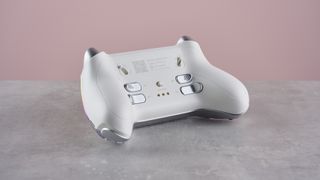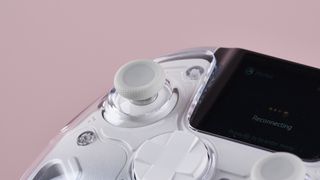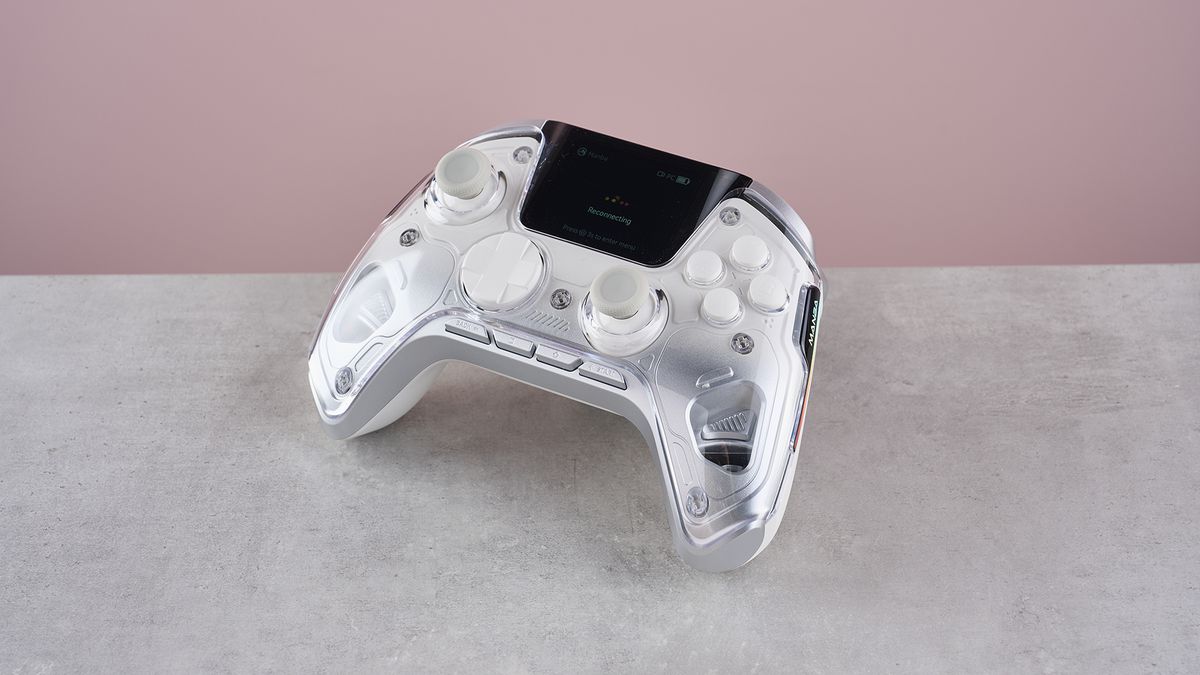Products You May Like
Manba One: one-minute review

The Manba One is a wireless controller with an inbuilt screen for accessing the various tweaks available to tailor the gaming experience to your preferences.
Its design mimics the Xbox Wireless Controller, although the white variant features a removable transparent front cover that reveals some of the inner workings – which, along with the RGB lighting on either side, helps to make the Manba One more distinctive.
However, the relatively short grips caused me some discomfort, mainly due to the sharp angle at which they tail off towards the triggers. Those with smaller hands may be fine (although mine aren’t even that big), but I prefer the grip designs of popular controllers, such as the aforementioned Xbox controller and PlayStation’s DualSense.
The overall build quality is good: the face buttons are more akin to mouse clicks, but pleasingly tactile all the same, while the D-pad is more damped and operates smoothly. However, the rear ‘M’ buttons are too small and thin to be convenient, and all too easy to mispress. The bumpers are also a little awkward to reach given their thickness, and the triggers are quite short and less indented than those on some of the best PC controllers.
Worst of all, though, is that the left stick – on my unit at least – can stick in an elevated position, in turn causing it to get stuck in certain directions when using it, which is a serious problem. Thankfully, this issue was resolved easily by pressing the stick back into place, but it’s a design fault that needs to be addressed, if indeed it affects all units.
Since there’s no software for the Manba One, all adjustments are made via its onboard display, and thankfully the interface is clear and easy to use. From here, you can rebind buttons, activate turbo mode, and assign the four remappable M buttons to a series of button presses. You can also adjust trigger travel, as well as the deadzone and curve for the joysticks. Four profile slots are available to save your configurations, including one dedicated to Switch controls.
In practice, the Manba One performs well, on both PC and the Nintendo Switch. The buttons are snappy and easy to use, although the triggers don’t offer the most feedback, since their travel is quite short. However, the ability to lock the travel is a welcome addition, and proves very useful for shooters when you want to perform quick taps.
The joysticks are also precise and smooth, and the curve options do make a difference. I found that the High Performance curve, for instance, was especially useful for racing games, as it allowed for both precise micro-adjustments and full-lock steering quickly.
Given its asking price, the Manba One represents good value considering its features and performance. The official Xbox Wireless Controller is cheaper, but barebones in comparison, and it doesn’t even come with a rechargeable battery. If you’re after similar levels of customization, then you’ll usually have to part with a lot more cash. The Manba One, therefore, is a worthy choice for those after a precise, tweakable controller.
Manba One review: Price and availability
- $69.99 (about £54 / AU$105)
- Available now in Black and White colorways
- Good price compared to the competition
The Manba One costs $69.99 (about £54 / AU$105) and is available now. It comes in two colorways, black and white, the latter of which features a transparent front cover. The joysticks are replaceable, with a taller pair included in the box. Also included is a dock for wireless charging.
It’s more expensive than the Xbox Wireless Controller, one of the best PC controllers around and a popular choice for many PC players, but not by much. It has more features than this pad, including a built-in display, four programmable rear buttons, and numerous other tweaks and customizations. However, unlike the Xbox Wireless Controller, the Manba One has no 3.5mm headphone jack.
Compared to more feature-laden controllers, the Manba One looks like a veritable bargain. The Turtle Beach Stealth Ultra, for example – our pick as the best PC controller for those with cash to splash – is considerably more expensive. However, this gamepad is more advanced, featuring mechanical buttons and the headset audio control.
The Manba One matches it for joystick hardware, though, as both pads use Hall effect technology – but the thumbsticks themselves can’t be switched out on the Stealth Ultra, as they can on the Manba One. Also, as mentioned in our Turtle Beach Stealth Ultra review, we weren’t fans of its companion software.
Manba One review: specs
| Price | $69.99 (about £54 / AU$105) |
| Dimensions | 6.1 x 4.3 x 2.6 inches (155 x 108.5 x 65.5mm) |
| Weight | 10.4oz (295g) |
| Compatibility | PC, Nintendo Switch, Android and iOS |
| Connection type | Wireless (Bluetooth), Wired (USB-C) |
| Battery life | About 10 hours |
| Software | None |

Manba One review: design and features
- Inbuilt screen
- Snappy, tactile buttons
- Some comfort issues
The Manba One adopts a rather classic controller design, with a similar shape and layout to Xbox controllers, but with a slightly more angular, aggressive appearance. There’s also some customizable RGB lighting on the sides to liven up proceedings, as well as some subtle gray accents on the white variant.
This colorway also features a transparent front cover, letting you see the exoskeleton lurking beneath, which fades to silver towards the bottom. The rear of the pad is lightly textured on the grips, but there’s no additional padding as some of the best PC controllers and best Xbox controllers feature.
The grips themselves are also quite short and curve abruptly towards the triggers. As a result, I didn’t find the Manba One as comfortable to hold as more popular controllers, such as the Xbox controller and PlayStation’s DualSense. However, those with smaller hands may have no issue.
Compared to those other controllers, the face buttons on the Manba One are less damped as well, feeling and sounding more like mouse buttons, but satisfying to use nonetheless. The D-pad, though, feels more cushioned and is smooth to operate. The sticks are average in size and feature a soft rubber material on top, offering just enough grip. A taller pair of sticks are included in the box and are easy to replace.
The triggers are another point of departure for the Manba One. They’re quite short with shallow indentations, and offer less travel and resistance than you might expect. However, the stroke lock is a clever addition, as it reduces travel considerably to allow for rapid firing.
Another welcome feature is their dotted texture, which does help with grip. This can also be found on the bumpers, although it’s a shame these are bulky with an awkward shape, as it makes them uncomfortable to use for long periods. Thankfully, the same can’t be said about the home buttons: these are positioned right at the bottom of the controller, below the D-pad and right analog stick. This keeps them out of the way, yet they’re still easy to access when needed.
The build quality of the Manba One is hard to fault – in most places. The screen is prone to micro-scratches all too easily, but more worrying is an issue I experienced on my test unit: the left analog stick managed to get stuck in a raised position, and in this state, it would in turn catch in certain directions when operating it – a cardinal sin for any joystick. Thankfully, this was a one-off problem, and simply pushing the stick back down into its original, intended seat was enough to prevent it reoccurring. However, it’s still a fault worth noting.
The included charging station matches the simple yet sleek design of the controller itself, into which the Manba One fits like a glove. It also features a compartment underneath to store the sizable Bluetooth dongle.
There’s no external software app for the Manba One on either PC or mobile: every adjustment and tweak is made via a menu displayed on its screen. There are options to rebind buttons and toggle turbo mode, as well as assign the four back M buttons to a series of up to 20 buttons in a row.
You can also adjust the deadzone for the analog sticks, as well the curve. There are four options to choose from on this front, ranging from a default, linear curve to a High Performance option, which Manba claims is ideal for racing and shooting games.
There are four profile slots to store your setups, including one dedicated to Switch controls, but unfortunately, you can’t rename them. There are also tools for testing buttons and calibrating the joysticks, triggers, and motion control (for the gyroscope when playing certain Switch games). You can set the vibration strength too, with four levels to choose from, or turn it off completely.

Manba One review: performance
- Snappy and responsive
- Useful adjustments
- Triggers lack feel
Gaming with the Manba One is mostly an enjoyable experience. The sticks offer smooth and precise movements, while the buttons are responsive and tactile. However, the triggers fail to offer the best feedback, as their travel is too short to offer the kind of finely graded control you want from analog inputs. The underneath M buttons are also hard to use in the heat of the moment, given their small size and awkward position; you can’t use a more flat-fingered approach, as you can with a more traditional, paddle-like designs.
Personally, I’ve always preferred D-pads with separate buttons for each direction, rather than the integrated design on the Manba One, as I find they give me more control and precision in games where such inputs are crucial. I needn’t have worried, though. When playing Tekken 8, for instance, where D-pad inputs are complex, I had little issue hitting the directions I wanted to hit. That circular shape also helps to roll seamlessly between multiple directions, yet each is still easy to actuate individually without accidentally triggering adjacent directions, which can happen on D-pads with a singular component.
The various tweaks available on the Manba One also made a difference. Using the High Performance curve for racing games, for instance, was a marked improvement. When playing Assetto Corsa, it offered much better car control, as I could make minute steering corrections and drastic changes of direction equally well, depending on how far I moved the stick.
This same curve is also recommended for shooters, although I found that the default, linear curve offered less sensitive and more precise looking and aiming. The locks on the back that shorten the trigger length also work for enabling rapid shooting.
One of the great advantages of the display is the ability to adjust settings on the fly. Accessing the menu mid-game works well for the most part, although having to hold the home button for three seconds to activate it is a little inconvenient; I wish it were a little quicker.
It’s a shame also that the M buttons can’t be programmed as modifiers; to toggle the curve of the analog sticks, for instance, which would be useful for situations requiring momentary decreases in sensitivity, such as aiming, acting like a sniper button on a mouse. I found the M buttons all too easy to trigger too, especially when using the D-pad or face buttons intensely, as I naturally tightened my grip on the back of the controller.
In addition to PC, I also used the Manba One with a Nintendo Switch, connecting via Bluetooth without needing the included dongle. Like the best Nintendo Switch controllers, connecting the Manba One to the console is easy, and it worked flawlessly.
The battery life of the Manba One is claimed to be about 10 hours or more, and this was roughly in line with what I experienced, although it was hard to get an accurate measurement of battery levels, since no percentage is given on the inbuilt screen. Charging via the included dock takes about four and a half hours according to Manba, and again this proved relatively accurate.

Should I buy the Manba One?
Buy it if…
Don’t buy it if…
Also consider…
If the Manba One isn’t doing it for you, here’s a couple of other controllers we recommend
| Row 0 – Cell 0 | Manba One | Xbox Wireless Controller | Victrix Pro BFG |
| Price | $69.99 (about £54 / AU$105) | $59.99 / £54.99 / AU$74.99 | $179.99 / £179.99 / AU$269 |
| Dimensions | 6.1 x 4.3 x 2.6 inches (155 x 108.5 x 65.5mm) | 6 x 4 x 2.47 inches (152 x 102 x 63mm) | 6.3 x 4.1 x 2.4 inches (160 x 105 x 60mm) |
| Weight | 10.4oz (295g) | 10.1oz (287g) | 10.5oz (298g) |
| Compatibility | PC, Nintendo Switch, mobile | PC, Xbox Series X, Xbox Series S, Xbox One, mobile | PC, PS5, PS4 |
| Connection type | Wireless (Bluetooth), Wired (USB-C) | Wireless (Xbox Wireless, Bluetooth), Wired (USB-C) | Wireless (2.4GHz), Wired (USB-C) |
| Battery life | 10 hours | 40 hours (AA batteries) | 20 hours |
| Software | None | Xbox Accessories | Victrix App |
How I tested the Manba One
- Tested for several days
- Played a variety of genres on PC and Switch
- 25+ years gaming experience
I tested the Manba One for several days. During that time, I used it to play a variety of titles, including shooters, racing simulators and fighting games, in order to test every aspect of the controller. These included Black Mesa, Metal Gear Solid 3: Snake Eater – Master Collection Version, Assetto Corsa, and Tekken 8. I tested the Manba One on PCs – both Windows 10 and 11 – and the Nintendo Switch.
I also made sure to use and tweak every available feature and setting on the Manba One via the built-in display. I also tried out the included replaceable joysticks and the wireless charging dock.
I have been gaming for over 25 years across numerous platforms, all the way from the NES and other Nintendo consoles to most generations of PlayStation and PC. During that time I have used a number of controllers, from official devices to third-party ones. I’ve also tested many other gaming peripherals, including mice and keyboards.
